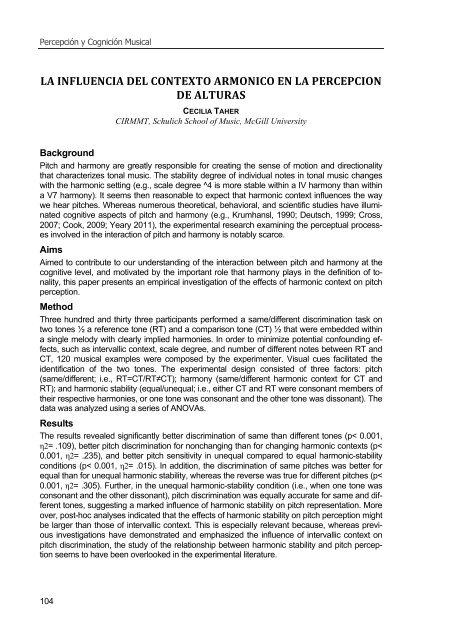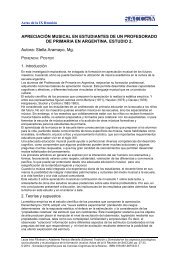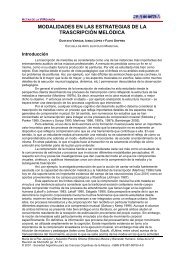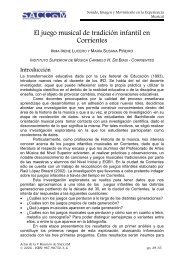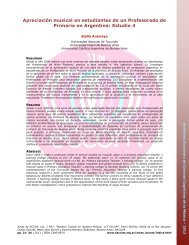NUESTRO CUERPO NUESTRA MÃSICA - Facultad de Bellas Artes
NUESTRO CUERPO NUESTRA MÃSICA - Facultad de Bellas Artes
NUESTRO CUERPO NUESTRA MÃSICA - Facultad de Bellas Artes
Create successful ePaper yourself
Turn your PDF publications into a flip-book with our unique Google optimized e-Paper software.
Percepción y Cognición Musical<br />
LA'INFLUENCIA'DEL'CONTEXTO'ARMONICO'EN'LA'PERCEPCION'<br />
DE'ALTURAS'<br />
CECILIA TAHER<br />
CIRMMT, Schulich School of Music, McGill University<br />
Background<br />
Pitch and harmony are greatly responsible for creating the sense of motion and directionality<br />
that characterizes tonal music. The stability <strong>de</strong>gree of individual notes in tonal music changes<br />
with the harmonic setting (e.g., scale <strong>de</strong>gree ^4 is more stable within a IV harmony than within<br />
a V7 harmony). It seems then reasonable to expect that harmonic context influences the way<br />
we hear pitches. Whereas numerous theoretical, behavioral, and scientific studies have illuminated<br />
cognitive aspects of pitch and harmony (e.g., Krumhansl, 1990; Deutsch, 1999; Cross,<br />
2007; Cook, 2009; Yeary 2011), the experimental research examining the perceptual processes<br />
involved in the interaction of pitch and harmony is notably scarce.<br />
Aims<br />
Aimed to contribute to our un<strong>de</strong>rstanding of the interaction between pitch and harmony at the<br />
cognitive level, and motivated by the important role that harmony plays in the <strong>de</strong>finition of tonality,<br />
this paper presents an empirical investigation of the effects of harmonic context on pitch<br />
perception.<br />
Method<br />
Three hundred and thirty three participants performed a same/different discrimination task on<br />
two tones ½ a reference tone (RT) and a comparison tone (CT) ½ that were embed<strong>de</strong>d within<br />
a single melody with clearly implied harmonies. In or<strong>de</strong>r to minimize potential confounding effects,<br />
such as intervallic context, scale <strong>de</strong>gree, and number of different notes between RT and<br />
CT, 120 musical examples were composed by the experimenter. Visual cues facilitated the<br />
i<strong>de</strong>ntification of the two tones. The experimental <strong>de</strong>sign consisted of three factors: pitch<br />
(same/different; i.e., RT=CT/RT≠CT); harmony (same/different harmonic context for CT and<br />
RT); and harmonic stability (equal/unequal; i.e., either CT and RT were consonant members of<br />
their respective harmonies, or one tone was consonant and the other tone was dissonant). The<br />
data was analyzed using a series of ANOVAs.<br />
Results<br />
The results revealed significantly better discrimination of same than different tones (p< 0.001,<br />
η2= .109), better pitch discrimination for nonchanging than for changing harmonic contexts (p<<br />
0.001, η2= .235), and better pitch sensitivity in unequal compared to equal harmonic-stability<br />
conditions (p< 0.001, η2= .015). In addition, the discrimination of same pitches was better for<br />
equal than for unequal harmonic stability, whereas the reverse was true for different pitches (p<<br />
0.001, η2= .305). Further, in the unequal harmonic-stability condition (i.e., when one tone was<br />
consonant and the other dissonant), pitch discrimination was equally accurate for same and different<br />
tones, suggesting a marked influence of harmonic stability on pitch representation. More<br />
over, post-hoc analyses indicated that the effects of harmonic stability on pitch perception might<br />
be larger than those of intervallic context. This is especially relevant because, whereas previous<br />
investigations have <strong>de</strong>monstrated and emphasized the influence of intervallic context on<br />
pitch discrimination, the study of the relationship between harmonic stability and pitch perception<br />
seems to have been overlooked in the experimental literature.<br />
104


